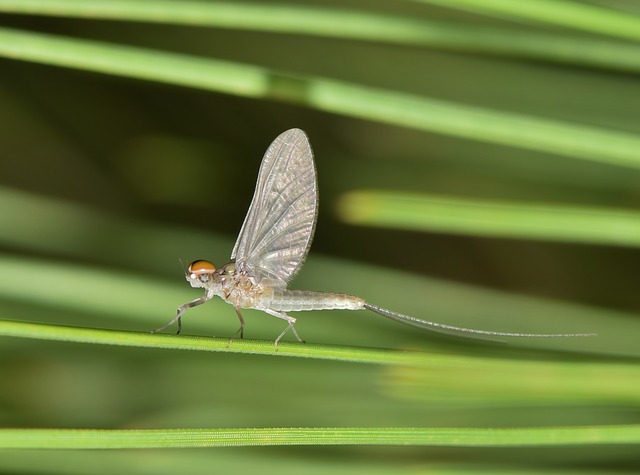Ancient Day Flies
Age and time are quite relative, my dear friend. While a week might not seem that long to us, to a day fly it is an incomprehensibly long period.The term "Ancient Day Fly" is used to refer to a small subpopulation of adult day flies, which in sharp contracts to the rest of their species exhibit an extraordinarily long lifespan of up to three years. While this timespan at first doesn't seem all that impressive, given that many species in Cenorad can live for several centuries if not millenniums, to an adult day fly this is a downright eldritch amount of time, given that their life can usually be measured in hours if not minutes. Unlike other creatures and individuals who manage to live far beyond their natural lifespan, the longevity of the Ancient Day Fly is neither the result of an intentional plan nor a cruel punishment but is instead entirely accidentally. For Ancient Day Flies receive their long-lasting life as the side effect of an unintentional infection with a rare fungal lifeform, known as a Wingclipper Mold, which normally feeds off the digestive system of various species of birds. Given the great discrepancy between the lifespan of the mold's usual hosts and a regular day fly, the mold is forced to abandon its parasitic lifestyle and instead switch to a symbiotic approach in order to extend the fly's life for long enough to be able to switch to a more suitable host.
/* by becoming a dead-end host for the normally highly pathogenic Flyslayer Mold through the unintentional infection with the normally highly pathogenic Flyslayer Mold, which planned nor "Sitting in the same boat", Fungi wants to live and therefore has to extend the life of the Fly or die with it. The way in which certain day flies managed to reach this unfathomable age lies in a rather strange symbiosis with the normally pathogenic " Flyslayer mold". Also known as "100-Day Fly", "Allday Flies" or "Fermenter Flies" The so-called "Ancient Day Flies" are Imagos of Day flies that live in a rather strange symbiosis with the normally pathogenic " Flyslayer mold", are commonly called "Fermenter Flies". During their last molting, the flies lose functional mouth/ large parts of their digestive system and therefore usually starve to death shortly after they have fulfilled their reproductive duty. Ferment plant saps, and even Fairy dust and therefore are able fungal growth within the fly's abdomen. given that the fungi have become interwoven with their internal organs or flat out replaced them.*/
Basic Information
Anatomy
While the external anatomy of an Ancient Day Fly remains relatively unchanged, apart from a white-colored fungal meshwork at its abdomen, their internal anatomy is heavily remodeled by the Wingclipper Mold in order to better allow the fungi to replace the fly's digestive system, which it had lost during the last stage of its metamorphosis.
Genetics and Reproduction
As Ancient Day Flies are merely the product of a parasitic fungus attempting to survive within a dead-end host, they don't reproduce but instead, sporadically appear whenever such an infection occurs.
Dietary Needs and Habits
Ancient Day Flies sustain or rather are sustained by their symbiotic fungi, which in turn consumes a great variety of rotting biomatter.
/* including overripe fruits and */
Additional Information
Uses, Products & Exploitation
Ancient Day Flies are commonly nicknamed "Fermenter Flies" as they can be used to create a special brand of alcoholic beverage, known as "Flyshine", which is tradionally made by trapping several flies in a barrel filled with overripe fruits.
/* Barrels of Flies makes a special brand of the alcoholic beverage known as Summer/Spring known as Fermenter Flies --> Alcoholic beverages, by trapping them in barrels --> Liquid is frequently replaced. */
Scientific Name
Ephimria brumaris X Orneophothyra muscara
Lifespan
2-3 years
Average Length
3-120 mm, depending on Day Fly species.
Body Tint, Colouring and Marking
As they grow older their coloration become more and more faded.
Grove of the Ancients
Given that Fungos-flavored Fairy Dust greatly enhances the chances for the creation of an Ancient Day Fly, areas that are heavily permeated by the currents of the Kyfe River are commonly home to entire swarms of these creatures./* As Wingclipper Mold requires a notable concentration of Fungos-flavored Fairy Dust in its environment to be able to perform the radical changes to its biology, needed or the creation of an Ancient Day Fly, these creatures generally only form in areas which */
Old Brown Wing
"Old Brown Wing" is the name given to the presumed oldest specimen of an Ancient Day Fly, which was discovered living the maze-like undercity of the Iron Ring Atoll. Unlike other flies of its kind, Old Brown Wing is not infected by a Wingclipper Mold but instead serves as the host for a low-class Mycare Fairy, which enables it to directly tap into the currents of the Kyfe-River and therefore at least theoretically sustains itself indefinitely. While the actual age of this fly is unknown it is at least several hundred years old, if one assumes that it was created during the events of the Second Spring.Remove these ads. Join the Worldbuilders Guild









Comments